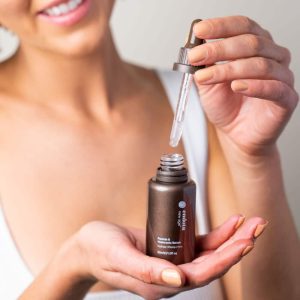Hands up if your skin has ever experienced sensitivity? You may have experienced the symptoms (redness and inflammation, as well as persistent dryness, flakiness, or tightness) but you might not know the cause, or how to heal it.
When it comes to sensitivity, it’s worth noting that there’s a difference between sensitive and sensitised skin – and determining the triggers that influence these is helpful in better understanding your skin.
endota skin expert and education coordinator Kimberley Conboy explains the key differentiating factor is that one is a skin type, whereas the other is a condition (that thankfully can be easy to avoid and treat). Kimberley explains that, “Truly sensitive skin is a skin type we are born with and it cannot really be cured, only managed. Sensitised skin, however, is a condition which will change depending on triggers and the environment, and is often flushed from touch, topical ingredients, or the weather, and symptoms can come on very quickly.”
If you’re challenged by the latter, often caused by overzealous application of active ingredients, frequent exfoliation or heavily fragranced products, you’ll be noticing the telltale signs of your skin barrier not functioning properly. Fortunately, there’s many ways you can protect and boost your barrier, whether compromised or not.
what is a skin barrier?
In dermatology, our skin barrier is known as the epidermis – put simply, it’s the outermost layer of the skin and the part you can see – which acts as the gatekeeper to the deeper layers of your skin. Composed of lipids, ceramides, and natural moisturising factors, the skin barrier is a shield that protects the dermis from the perils of the outside world. Its primary purpose is twofold: to keep harmful substances out (think: irritants, bacteria and pollutants) and to lock essential moisture in. But when this barrier is impaired, it’s unable to hold onto the goodness that keeps skin cells intact, leaving it more susceptible to external aggressors.
To get specific, there are three parts to your skin barrier:
the microbiome
An ecosystem of microorganisms (mostly bacteria) that live on and in the layers of our skin which are in constant communication with our environment. The microbiome is responsible for nutrient absorption and protecting our skin from pathogens.
the acid mantle
Located under the microbiome, the acid mantle acts as our skin’s first line of defence. Its job is to ensure structural integrity of your skin by coating it in a thin film that keeps the good stuff in and the bad stuff from penetrating your skin.
the lipid barrier
Found beneath the acid mantle, its main purpose is to keep our bodies hydrated and prevent water loss. If you think of the skin cells as building blocks, lipids are the glue that holds the blocks together.
So how to tell if your skin barrier is more on the compromised side? Kimberley explains that “it’s pretty easy to spot whether your skin barrier has been compromised. Signs to look out for include sensitive, inflamed or irritated skin, bacterial or fungal infections, delayed wound healing and itchiness.”
Most often, barrier damage comes as a result of stripping your skin of its natural oils from the overuse of acids, exfoliants and active ingredients. But this isn’t to say that any of these things are bad for the skin, they just need to be used delicately and in moderation. So the next time you find a product you’d like to try, you’re better off integrating it into your skincare routine slowly before building up to regular, consistent use.
repairing a compromised skin barrier
All skin types benefit from a skin strengthening routine, so when in doubt, put down the vitamin A or retinol and any other actives, and simplify your skincare lineup if you’re noticing increased sensitivity. As this is your skin’s way of alerting you to the fact that your barrier is needing some extra gentle love.
The key to rebuilding your barrier requires a gentle and consistent approach. This means dialling back your routine to the basics and choosing specially formulated products that will aid its recovery. Hyaluronic acid, ceramides and niacinamide (known for their hydrating, restorative and soothing properties) are the hero ingredients in a barrier-strengthening regime. Steer clear of abrasive scrubs and exfoliants , high strength actives and acids, and to err on the side of caution, ditch foaming cleansers too – as these can weaken your skin’s defence system and strip sensitised skin of much needed moisture.

To up the healing ante, consider incorporating LED Light Therapy into your next facial, in which the skin uses the light as a source of energy to painlessly speed up the repair and rejuvenation of damaged cells. The best part? Light Therapy can be tailored to suit various skin concerns depending on the light colour and wavelength used, “It’s ideal for most skin types, but it is particularly beneficial for prematurely aged, sun-damaged skin and dehydrated or dry skin types,” says Kimberley.
less is more
Not sure where to begin? This routine promises to rescue a skin barrier in need of some TLC.
- Start with a pH-balanced, non-stripping cleanser to remove impurities while maintaining your skin’s natural moisture balance. We recommend the New Age™ Sensitive Cleansing Milk
- Follow up with a hydrating mist containing humectants that bind moisture to the skin, like the Organics™ Hydrate Me Mist
- Incorporate a serum rich in hyaluronic acid and niacinamide to replenish and fortify your skin. Try the New Age™ Peptide 8 Hyaluronic Serum
- Seal in moisture, and improve your skin’s resilience and overall health with an oil. We suggest the rejuvenating Organics™ Vitamin Treatment Oil
- Apply a nourishing moisturiser formulated with ceramides and emollients to keep skin soft and soothed such as the New Age™ Sensitive Repair Moisturiser
- For your morning routine, use a sunscreen rich in antioxidants to protect against sun exposure and UV rays.
The good news is that a skin barrier can be restored with little time and effort. Typically, (and depending on the extent of the damage) it takes 4-6 weeks of a pared back approach to get your skin barrier functioning as normal, and anywhere up to a couple of months to get it to its protective best. And remember, prevention is always better than cure, so using gentle and nourishing ingredients year-round will ensure a robust barrier – which is the secret to happy, healthy skin.
For tips on skincare that works while you slumber, read our blog on overnight hydration.


